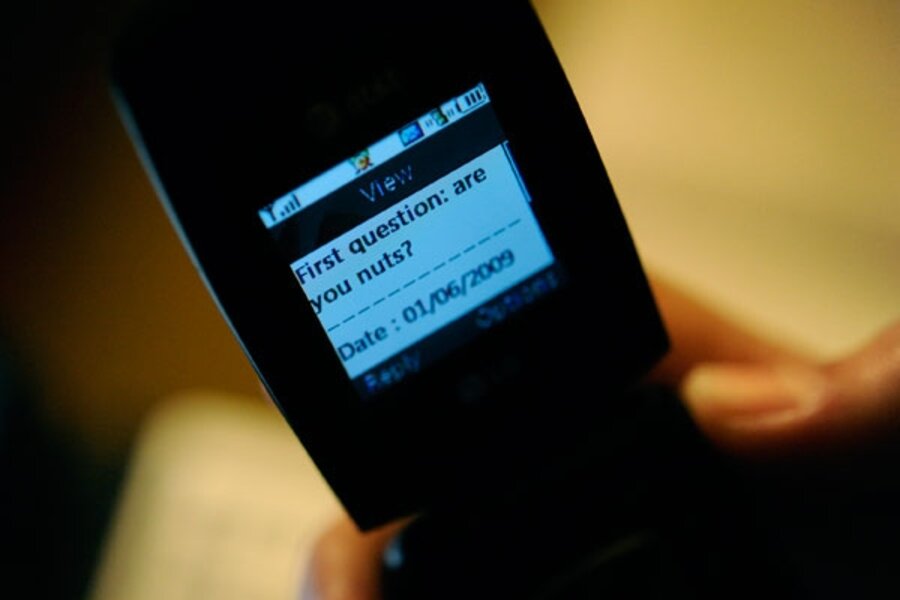Some sobering stats on texting while driving
Loading...
On the one hand, I love texting on my iPhone. My wife and I often send each other text messages when she’s in a meeting at work, or I’m on a conference call at home. We don’t bother each other, but still get the message.
On the other hand, I hate texting, especially when it’s being done by someone behind the wheel of a car (or a Green Line trolley in Boston, but more on that below).
From the urban dictionary: "Text-end: When a text-messaging-distracted driver rear-ends the vehicle in front of [him]...."
True story: About three months ago, I pulled up to a stop sign in Falls Church, Va., near where I live. A young woman in a sporty car pulled up beside me. As she pulled up, I noticed she was texting on a cellphone, barely paying attention to what was happening around her. She continued to text through the stop sign and right up to the next stoplight. My car was still next to hers, so I rolled down my window and motioned to her. She looked puzzled and rolled hers down as well. I told her that she was endangering the life of every single person on the road if she continued to text while driving. Her reply was somewhat expected. She made a rude gesture with a certain digit and roared away when the light turned.
Driving while texting (DWT) is becoming a real problem. A real and dangerous problem. It’s bad enough that people can’t seem to stop themselves from talking on cellphones while driving. (Raise your hand if you’ve almost been hit by someone talking on his or her cellphone while driving. I see, almost everyone.) But at least cellphone talkers could pay some attention to the road. Not so with those DWT.
In a survey released last week by Vlingo Corp., a Cambridge, Mass., company that develops speech-recognition technology for mobile phones (and so, of course with a vested interest in the survey's outcome, so keep that in mind), more than 26 percent of some 4,800 cellphone users surveyed across the United States admitted they had sent text messages while driving. The worst state was Tennessee, where 42 percent of those surveyed said they had done DWT.
But here is the kicker: While more than 26 percent of those surveyed said they texted while driving, 83 percent said the practice should be illegal. (Currently seven states and the District of Columbia outlaw it.) So if my math is correct, this means that at least 9 percent of those surveyed text even though they think it’s a bad thing.
Ah, humans. The spirit is willing, but the thumbs are twitchy.
It’s likely the 17 percent who said it should not be illegal are between the ages of 18 and 29. According to a Pew Research Center study last year, 74 percent of Americans in this age group use text messaging. A lot. And DWT does seem to be inversely proportional to the age of the driver – the younger you are, the more likely you are to do it. The Vlingo study found that 58 percent of teenagers did it, as did 49 percent of those aged 20 to 29. A little more than 13 percent of those aged 50-59 did so.
But it’s no joke. And the bigger the vehicle your driving, the greater the danger. Just ask the people who were on the Boston Green Line trolley that smashed into the back of another one recently. At the time of the accident, the driver was texting his girlfriend, he admitted. Dozens were injured, the driver lost his job, and the MBTA said it would ban on-the-job cellphone use and fire anyone caught using a cellphone, pager, or similar device during working hours.
But at least no one was killed in that accident. The same is not true of the horrific accident last September in California when, it is speculated, a train operator may have missed a stop signal because he was texting shortly before the accident.
Last year, Mark Melrose of Mountainside Hospital in Montclair, N.J., a spokesman for the American College of Emergency Physicians, told USA Today that most people probably don’t initiate text messages while driving, but find it hard not to respond if they receive one.
"It's hard to ignore the temptation," he said. "You think, 'This might be important, I'd better check.' You know you shouldn't be doing it, but you do it anyway."
It’s time for the other 43 states to act. No texting of any kind, even (sorry Vlingo) speech texting, which still quadruples your chances of having an accident. But making laws isn’t the complete answer. Yes, it might stop older people from doing it. But I also think we need to attack DWT the way we attacked smoking, or drinking and driving. We have to deprive it of its coolness factor for young people.
Making it seem as stupid and dangerous as it really is will save a lot more lives than just saying in an adult voice, “Now kids, don’t you do that!”





